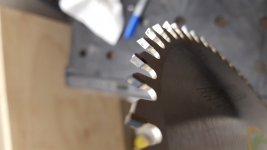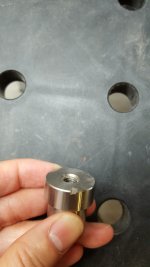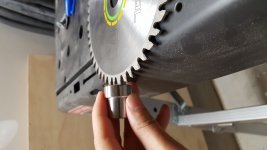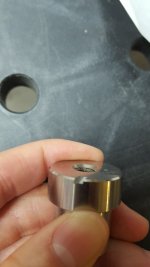GoingMyWay
Member
- Joined
- Oct 11, 2017
- Messages
- 3,784
When I originally made my custom tracksaw cutting station I followed Peter Parfitt's advice and made sure not to drill a hole that would fall directly in line with the tracksaw cutting path. My custom tracksaw cutting station was made out of a 2' x 4' piece of MDF and I set it up to allow me to make my cuts along the shorter 2' side.
This past weekend I started building my end grain cutting board using pre-milled 21" long lumber. I figured it would be easier if I was making my rips along the 4' side of the station. I had already pre-drilled the full pattern of 3mm holes so it took no time at all to add several new 20mm holes along the longer side of the cutting station where I thought most appropriate. In my haste I didn't really stop to think about where the parf dogs might be in relation to the guide rail.
Sure enough I had not only drilled a hole but also actually placed a parf dog right into the cutting path of my TS55 with the 48 tooth blade. After my first cut in the new orientation I sadly discovered that I had ever so slightly hit the parf dog. I casually inspected the blade and didn't see any obvious signs of damage. I probably should have taken the blade off for a thorough inspection, but I didn't and I continued on making lots more rip cuts. These cuts seemed fine.
Since I didn't see any obvious damage and the subsequent cuts seem fine I was guessing that the stainless steel was soft enough not to hurt the carbide. You can kinda see the nicked parf dog in the attached picture.
Think my blade is ok or did I mess it up?
This past weekend I started building my end grain cutting board using pre-milled 21" long lumber. I figured it would be easier if I was making my rips along the 4' side of the station. I had already pre-drilled the full pattern of 3mm holes so it took no time at all to add several new 20mm holes along the longer side of the cutting station where I thought most appropriate. In my haste I didn't really stop to think about where the parf dogs might be in relation to the guide rail.
Sure enough I had not only drilled a hole but also actually placed a parf dog right into the cutting path of my TS55 with the 48 tooth blade. After my first cut in the new orientation I sadly discovered that I had ever so slightly hit the parf dog. I casually inspected the blade and didn't see any obvious signs of damage. I probably should have taken the blade off for a thorough inspection, but I didn't and I continued on making lots more rip cuts. These cuts seemed fine.
Since I didn't see any obvious damage and the subsequent cuts seem fine I was guessing that the stainless steel was soft enough not to hurt the carbide. You can kinda see the nicked parf dog in the attached picture.
Think my blade is ok or did I mess it up?





